A MATTER OF TASTE
Most Important, to Me at Least
Hints of summer already are here, not outside, but in the seed catalogues in my mailbox, on seed racks in stores, and from emails from seed companies. Look how many different varieties of each vegetable are offered! Thumbing through one (paper) catalogue, for example, I see twenty-eight varieties of tomato, seventeen varieties of peas, and eleven varieties of radishes. Anyone who has gardened for at least a few years has their most and least favorite varieties of vegetables. Here’s a sampling of mine. 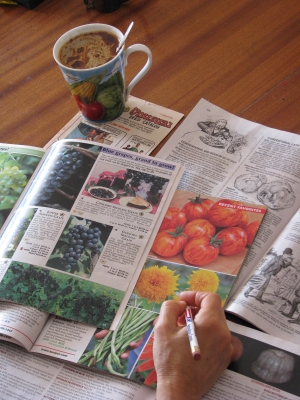
Right from the start, I admit that most important to me in choosing a vegetable variety is flavor. I’ll grow a low-yielding variety, even one that’s not particularly resistant to insects or diseases, if it is particularly delectable. Within reason, of course.
Let’s start with one of the most widely-grown backyard vegetables, tomatoes.
The best-tasting varieties I have grown are Sungold, Belgian Giant, Amish Paste, Anna Russian, Paul Robeson, and Pink Brandywine). Not that these are the only great-tasting varieties. Lots of the other Brandywine variations are also in this category, as are Carmello, Valencia, and Nepal. What I definitely stay away from is any determinate variety; these are bushy types with less leaf area per fruit.
Years ago when I planted many more varieties, I realized that I would just walk right on past notably good — or perhaps they’re just heavily promoted — varieties like Beefsteak and Rutgers if any of my favorites also are ripe; so I no longer grow those “notably good” varieties.
For a canning tomato, San Marzano is a variety that cooks down to a sauce that is rich in flavor and red color, far superior to other canning varieties like Roma or Heinz 2653.
I only eat my peppers red or yellow or whatever their color is when ripe, so need a variety that not only tastes good but also ripens in due time this far north. The usual go-to, recommended variety is Ace, or one of its variations. “Extra-early, highly productive.” True. But great tasting? No. 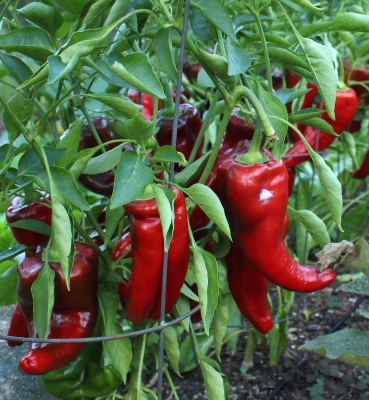 For the the best-tasting, productive, earliest ripening pepper, Sweet Italia is the one. Right up therewith Sweet Italia is a new variety, Picnic Orange, although not as productive. And not quite as good, but very productive, is Carmen, also worth my growing.
For the the best-tasting, productive, earliest ripening pepper, Sweet Italia is the one. Right up therewith Sweet Italia is a new variety, Picnic Orange, although not as productive. And not quite as good, but very productive, is Carmen, also worth my growing.
Legumes and a Grass
Peas get a lot of publicity in the world of gardening these days, especially the new snap-type peas. With succulent, edible pods, snap peas yield more than shelling peas, and are easier to eat. I always plant a few feet of snap-peas, but I grow many more feet of shelling peas. Sugar Snap, the original snap pea, is the best in my opinion, even if the vines do soar to unwieldy heights.
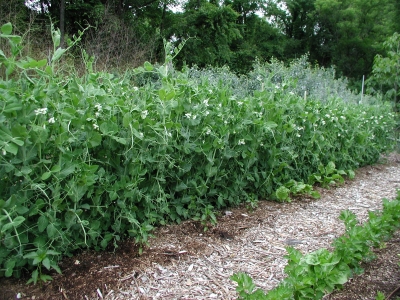
Peas on trellis
Preparing shelling peas for eating or freezing takes time, but it’s worth it. Shelling peas taste best. Lincoln and Green Arrow are two excellent varieties that have been around for a long while and are favorites of mine and many other gardeners.
I did once grow so-called leafless peas, which they truly are, but can’t remember how they tasted. My growing them only once might be telling. Seems to me more leaves would make for sweeter peas. One advantage these peas is their abundant tendrils allow the short vines to hold each other up when planted in a solid block.
My farmden lacks the long, warm growing season enjoyed by lima beans, the best ones, at least. Back when I lived in southern Delaware, I could grow the delectable King of the Garden or Doctor Martin varieties. Bush limas mature sooner than pole limas; I recently grew Fordhook Henderson but decided their mediocre flavor wasn’t worth the space or the effort.
My favorite snap bean varieties are Scarlet Runner, Kentucky Wonder, and Blue Lake. Scarlet Runner beans are thick, hairy, and coarse, but taste good. If necessary, close your eyes when you eat them. But open your eyes to admire the plants, the clusters of scarlet flowers on display along the vines as they clamber up a pole or other support.
Kentucky Wonder has a good, old-fashioned green bean taste.
Blue Lake beans are the most refined of the lot, velvety smooth in texture and flavor.
Sweetness has been the traditional goal sought in sweet corn varieties . (Corn is botanically a grass.) The new “supersweet” hybrids have that in spades, with four times the sugar of regular sweet corn. But sweet corn can be too sweet, and I don’t like my (corn) ears to ripen all at once, which even regular hybrid varieties do. Golden Bantam is a good-tasting, non-supersweet, non-hybrid variety that has been around since the beginning of the last century.
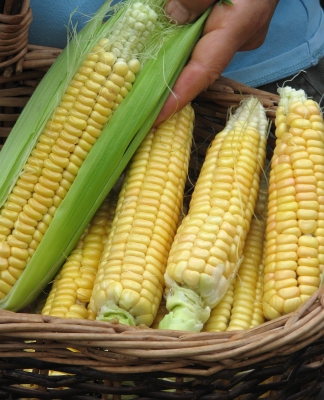
Golden Bantam-m-m-m-m
It’s sweet enough for me, with a real corny flavor and pleasantly chewy texture.
Other Considerations
Choosing a good variety is not the end-all in having a green thumb. With many types of vegetables, climate, soil, and growing conditions, not variety, are important determinants of flavor. That’s why I pick carrot varieties primarily on the basis of shape rather than purported flavor differences.
For some vegetables, it is texture that comes into play. No dramatic flavor differences exist within each category of lettuce, be it Romaine, Boston, iceberg, or loose leaf. All are at their best when grown in a fertile, moist soil to mature during cool days of spring or fall.

Other vegetables that are good when well-grown, but for which I haven’t found notable flavor differences among varieties, include spinach, turnips (except for the especially delectable Hakurei), summer squash, butternut squashes, and okra.



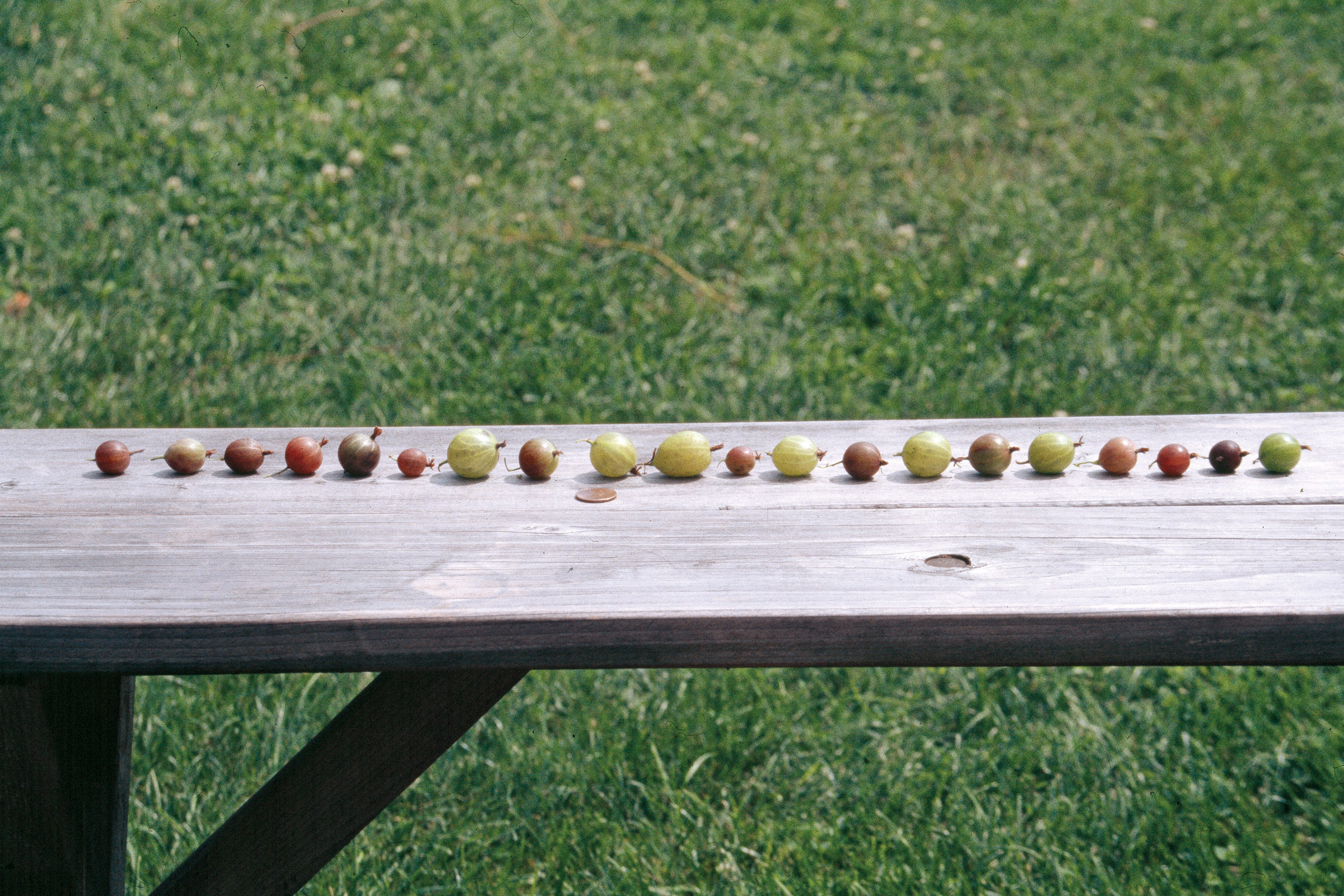
Hello, Lee! Now you’ve inspired me to start going thru my seed catalogs.
Here in Beacon, not far from you, Marconi peppers have been consistently ripened for me, starting in August. I love Kentucky Blue green beans, reliable, prolific, and tasty. And we’ll grow Brandywine forever, no matter how ugly and low yielding. Nothing tastes like summer the way a Brandywine BLT does!
Hello Lee,
I wanted to introduce myself. Your brother Andy and I have served on a local board of directors for a community center and we happened to be speaking the other day; I was telling him about my garden adventures and he explained about all of what you do!
Super impressive and I’m becoming a fan. I hope if and when you visit him here in RI you can stop by to see my project. Perhaps we can begin a correspondence.
I’m especially interested in saving my own seed as much as possible and wonder about your own seed saving versus going to the catalogue year in and year out.
Many thanks for listening and if nothing else I hope to enjoy much of your work and of
Your accomplishments via your blog.
Sowing peas soon,
Dan
Hi Dan, I save only a limited amount of seeds, mostly Sweet Italia peppers, Shirofumi, two popcorn varieties. Otto File polenta corn, and a few others. Glad you like my blog and it helps with your garden.
Where do you buy your sweet italia seeds? I have searched online for years and cannot find them.
Thanks!
They are hard to get. Search the web with the following terms, each with quotes: Sweet Italia pepper, Sweet Italian pepper, Italian Sweet pepper, Italia sweet pepper
Could you please tell me where to find Sweet Italia pepper seeds.
Thank you.
They are hard to get. Search the web with the following terms, each with quotes: Sweet Italia pepper, Sweet Italian pepper, Italian Sweet pepper, Italia sweet pepper.